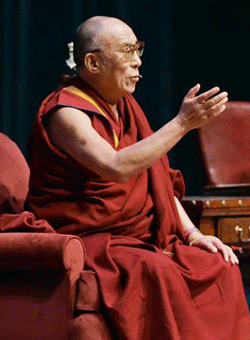
Tenzin Nordon, a 19-year-old college student whose parents fled China’s takeover of Tibet, came to perform a traditional good-luck dance for him.
Ngawang Tashi, a 33-year-old monk, came to hear the man he considers the world’s best teacher give him insight he can’t get anywhere else.
And Sara Conrad, a doctoral student in Tibetan studies at Indiana University, came to see a man who is not only an object of her scholarship, but the leader of a people under great duress.
For many reasons, fans and followers of the Dalai Lama – leader of Tibetan Buddhists worldwide and head of the Tibetan government in exile – turned out Tuesday to greet the Nobel laureate at the start of his sixth visit to Indiana.
“He is our spiritual leader,” Nordon said. “We look upon him for guidance.”
The Dalai Lama will deliver two days of religious teachings in Bloomington, starting today, before making a public speech Friday morning at Conseco Fieldhouse in Indianapolis.
On Tuesday, the Dalai Lama was welcomed at the Tibetan Mongolian Buddhist Cultural Center in Bloomington with all the ceremonial pomp his followers could muster.
He was greeted at the Tibetan archway standing at the front of the cultural center grounds by a troupe of “good luck” dancers wearing white fur masks, tasseled robes and heavy ornamental boots.
They performed amid white plumes of incense and pounding drums.
Later, a pair of monks standing high atop a temple with gold- leafed statues blasted notes on long horns whose guttural noise symbolizes the strength of the Earth.
And the 74-year-old Dalai Lama, fresh off a lengthy series of flights from his exile home in India, walked the last hundred yards into the temple following another pair of monks playing ornate trumpets traditionally used to greet holy beings.
The Dalai Lama made no public statements upon his arrival. But he stopped at two new shrines on the cultural center grounds to offer short blessings.
He paused to offer his blessings and approval for a new sand mandala – a tabletop-size picture of a lotus blossom featuring the eight auspicious symbols of Buddhism – that took a team of monks more than eight days to construct using only colored sand drizzled from the tips of metal funnels.
And he paused to turn the prayer wheels attached to drums containing hundreds of thousands of written Buddhist prayers.
Nordon, whose parents fled the Chinese crackdown in Tibet about the same time as the Dalai Lama was exiled in 1959, is an American citizen who has lived most of her life in the Midwest. But she still feels the tug of her Tibetan heritage.
“We’re a culture that is diminishing away,” she said. “It’s important for us to preserve our culture.”
Tashi, a monk living in Kentucky who came to see the Dalai Lama, said he considers it good fortune to be in the presence of his faith’s spiritual leader.
“From a Buddhist point of view, we are blessed by His Holiness,” Tashi said.
As a native-born American, Conrad, the doctoral student at IU, has an odd advantage over most of the Tibetans who came to see the Dalai Lama.
The Chinese government rarely grants visas to Tibetan exiles, but she’s been to Tibet twice in recent years. The country is a fading memory for older Tibetans and a place younger Tibetans know only from stories.
Conrad, who gives English lessons to some of the Tibetan-speaking monks at the center, said the Dalai Lamas have had to flee invading Mongol or Chinese armies throughout history, only to return later. For her and others who came to see the Dalai Lama, a restored Tibet is their ultimate hope.
Conrad said America, a country that stands for freedom, should care about what happens to the Dalai Lama and Tibet.
“Suffering anywhere is suffering everywhere,” she said. “We shouldn’t turn our backs on these people.”
Author : Robert King
Source : http://www.indystar.com




